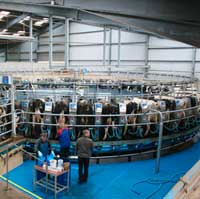Feeding cows as individuals will optimise yields and profits

Treating cows as individuals and going back to thinking like a cowman rather than a herdsman will optimise yields and profits, said South African dairy farmer Nigel Lok at this week’s British Cattle Breeders Club Conference, Telford.
According to Mr Lok, technology plays a major role in achieving these aims, particularly on large scale systems where individual cow feeding using advanced management systems can make a significant difference to performance.
At his 700-cow dairy farm, in the Tsitsikamma region, individual cow management and concentrate supplementation has meant concentrate use for every kilo of fat corrected milk (FCM) is 30% less than the district average and kilos of FCM for every cow and also for every hectare is 45% higher than the average.
“90% of breeding is feeding,” he said. “Concentrates make up the biggest input cost on most farms, but because cows have different genetic capabilities and metabolic rates, it is logical to feed cows individually where possible.
“It is also cost effective to feed the ingredients that make up concentrates separately to individual cow requirements.”
To achieve this, Mr Lok’s herd is automatically monitored using in-line milk meters to track butterfat, protein, lactose and SCC, weigh scales on the parlour exit and activity monitors.
The information gathered from these sources is used to determine individual concentrate requirements in line with stage of lactation, body condition score and lactation number.
At milking, all cows get a mineral pellet according to their individual information – whole maize, the mineral pellet, fats, ionic salts and a range of other ingredients are kept in individual silos and allocated at specific levels for specific cows.
The system also provides an early warning system for problems such as acidosis and mastitis.
“For example the butterfat/protein ratio dropping below 1.06 is an indication of acidosis. These cows will be automatically medicated with bicarb and mag oxide, with supplementation ceasing when the ratio corrects itself,” Mr Lok explained.
Activity meters will also pick up an increase in restlessness. “When this is paired with a reduction in milk lactose levels, the system identifies this individual as a likely mastitis case. This cow will be pulled out and a CMT test carried out.”
